Introduction to the Significance of Agriculture
Across the fertile plains of India, agriculture isn’t just a means of sustenance. it’s a testament to resilience and adaptation. From the lush rice paddies of the East to the arid fields of the West, each region has its unique agricultural practices, reflecting the diverse climatic conditions and cultural heritage. The intricate knowledge passed down through generations forms the backbone of agricultural sustainability, ensuring food security and rural livelihoods. As we delve deeper into the significance of agriculture in India, we uncover a tapestry of traditions, innovations, and challenges that continue to shape the nation’s agricultural landscape.
Read More: Demographic Features of Indian Population

Historical Context of Agriculture in India
The historical context of agriculture in India encompasses significant transformations and enduring challenges. During the colonial era, British policies such as the imposition of cash crops and land revenue systems led to the exploitation of Indian farmers and the decline of traditional agricultural practices. The period post-independence saw efforts to modernize agriculture through initiatives like the Green Revolution, aimed at increasing crop yields through the adoption of high-yielding varieties, irrigation infrastructure, and chemical fertilizers.
- Colonial Exploitation: British colonial policies during the 19th and early 20th centuries led to the exploitation of Indian farmers. Cash crop cultivation and the imposition of land revenue systems resulted in the displacement of traditional agricultural practices and economic hardships for farmers.
- Green Revolution: The 1960s witnessed the Green Revolution, a period of agricultural modernization aimed at increasing crop yields through the adoption of high-yielding varieties, irrigation infrastructure, and chemical fertilizers. This initiative, although successful in increasing food production, also had negative consequences such as environmental degradation and regional disparities.
- Shift Towards Sustainability: In recent decades, there has been a shift towards sustainable agriculture in India. Initiatives promoting organic farming, agroecology, and farmer cooperatives have gained momentum, aiming to address environmental concerns and improve the livelihoods of smallholder farmers.
- Technological Innovation: The introduction of technology, such as precision agriculture and digital platforms, has transformed farming practices in India. These innovations have enhanced productivity, reduced input costs, and improved market access for farmers, contributing to the modernization of the agricultural sector.
Read More: How Economic Growth has Damaged the Environment?

Main Importance of Agriculture in India
1. Contribution to National Income
The contribution of India’s agriculture sector to the national income has witnessed fluctuations over the years, varying from 61 percent in 1950-51 to 16.3 percent in 2021-22. Unlike some countries with highly developed agriculture, India’s agricultural sector still holds a significant share of the national income.
2. Supply of wage goods
The cooperative society emerges as a pivotal player in securing the distribution of vital commodities such as flour, rice, pulses, and oilseeds. Despite a substantial population surge, there’s been a remarkable proliferation in grain production, exemplified by the per capita daily cultivation of grains and pulses experiencing a notable uptick from 1951 to 2021-22.
Read More: Main Features of Indian Economy
3. Increase in Employment
Agriculture continues to serve as a cornerstone of employment in India, with about 46.2 percent of the populace involved in agricultural activities as of 2015-16. However, the disproportionate reliance on agriculture for employment underscores India’s developmental challenges, underscoring the imperative for broad-based economic expansion.
4. Agriculture and Industry
The initial stages of agro-industrial development in underdeveloped countries like India witness a symbiotic relationship between agriculture and industry. The development of agriculture not only provides raw materials for industries but also leads to increased income and market expansion, fostering overall economic development.
5. Agriculture and Foreign Trade
Agricultural commodities play a significant role in India’s foreign trade, contributing substantially to the country’s export and import markets. From tea and coffee to grains and oil, agricultural products constitute a considerable share of India’s total trade, underscoring their importance in international markets.
| Criteria/Crop | India’s Rank | Criteria/Crop | India’s Rank |
|---|---|---|---|
| Total Irrigated Area | 1 | Cultivable Land | 2 (1st USA) |
| Pulses | 1 | Wheat | 2 (1st China) |
| Jute | 1 | Rice (Paddy) | 2 (1st China) |
| Spices | 1 | Sugarcane | 2 (1st Brazil) |
| Milk | 1 | Fruits & Vegetables | 2 (1st China) |
| Butter and Ghee | 1 | Cotton | 2 (1st China) |
| Cashew Nuts | 1 | Tea | 2 (1st China) |
Read More: Problem of Poverty in India
6. Role in Internal Trade
Agriculture plays a pivotal role in India’s internal trade, driving economic activity in various sectors such as grains, fruits, milk, and pasta. The vibrant agricultural trade network supports livelihoods and sustains economic growth across the country.
7. Agriculture and Transport
Regional diversity in agricultural production necessitates efficient transportation networks to facilitate the movement of goods. States like Punjab, Haryana, and Uttar Pradesh have witnessed significant increases in agricultural production, leading to enhanced self-reliance and economic prosperity.
Read More: Economic Policy Changes in India since 1991
8. Food security
Food security refers to the availability, access, and affordability of food for all individuals within a population. In the context of agriculture in India, ensuring food security is a primary objective. India’s agricultural sector plays a crucial role in meeting the food requirements of its vast and growing population. By producing staple crops such as rice, wheat, pulses, and vegetables, agriculture contributes to fulfilling the dietary needs of millions of people across the country.
Read More: Agriculture in India
Conclusion
In conclusion, India’s agricultural sector holds immense significance both domestically and internationally. Its vital contributions to national income, employment, and global food security underscore the pivotal role agriculture plays in India’s economy and the world at large. As India continues to navigate the complexities of agricultural development, leveraging its strengths and addressing challenges will be essential for sustained growth and prosperity.
FAQ on Agriculture in India
What is Agriculture?
Agriculture is the practice of cultivating crops, raising livestock, and other activities related to the production of food, fiber, and other resources for human use.
What is the Importance of Agriculture in India?
Agriculture in India is vital for food security, employment generation, and economic stability. It contributes significantly to the nation’s GDP, provides livelihoods for a large portion of the population, and supports various industries.
What is the Meaning of Agriculture?
The meaning of agriculture encompasses the cultivation of crops, rearing of animals, and related activities aimed at producing food, fiber, and other resources essential for human consumption and economic development.

